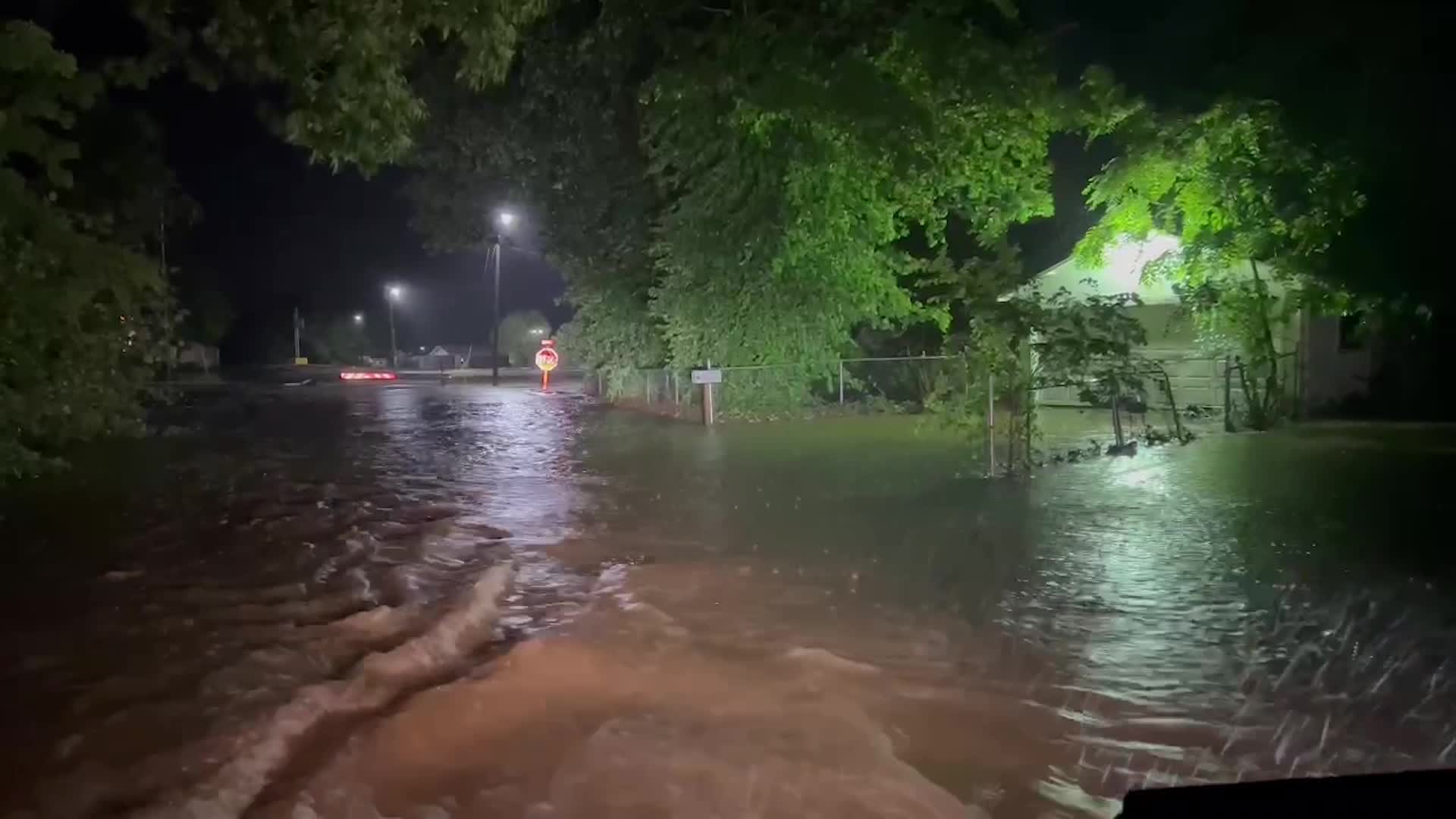Flash Flood Emergency: Causes, Effects, And Safety Measures

Table of Contents
Understanding the Causes of Flash Floods
Flash floods, characterized by their rapid onset and short duration, are devastating natural events. Several factors contribute to their formation, making understanding these causes crucial for preparedness.
Intense Rainfall
Intense rainfall is the most common cause of flash floods. The key is not just the amount of rain, but the rate at which it falls. Short, intense bursts of rainfall, particularly common during thunderstorms and monsoons, overwhelm the ground's capacity to absorb water. This is exacerbated by geographical factors like steep slopes, which accelerate water runoff, and impermeable surfaces such as paved roads and parking lots, preventing water from seeping into the ground. Areas with limited vegetation also contribute, as plant life helps slow down water flow.
- Heavy rainfall in a short period (e.g., several inches in a few hours).
- Saturated ground unable to absorb additional water, leading to surface runoff.
- Steep terrain accelerating water flow and increasing the speed of the flood.
- Lack of vegetation to absorb and slow down water runoff.
Dam or Levee Failures
The failure of dams or levees can trigger catastrophic flash floods downstream. These structures, designed to control water flow, can fail due to various factors, including: structural weaknesses from aging infrastructure, inadequate maintenance, erosion undermining foundations, overtopping due to excessive rainfall, or even human error. A sudden release of large volumes of water from a reservoir can rapidly overwhelm downstream areas, leading to devastating flash flood emergencies.
- Structural weaknesses in dams or levees due to age or poor construction.
- Erosion undermining the foundations of dams or levees, leading to instability.
- Overtopping of dams or levees due to excessive rainfall or unexpected surges.
- Sudden and uncontrolled release of water from reservoirs due to structural failure.
Sudden Snowmelt
In regions with significant snowfall, rapid snowmelt, particularly during spring, can cause flash floods. A combination of warm temperatures and heavy rainfall accelerates the melting process, overwhelming drainage systems. The resulting surge of water can quickly lead to a flash flood emergency, especially in areas with already saturated ground or limited drainage capacity. Mountainous regions are particularly vulnerable to this type of flash flooding.
- Rapid warming temperatures after a period of heavy snowfall.
- Increased water runoff from melting snow, overwhelming drainage systems.
- Inadequate drainage capacity in areas prone to snow accumulation.
- A combination of snowmelt and heavy rainfall exacerbating the situation.
Devastating Effects of Flash Flood Emergencies
The consequences of a flash flood emergency can be devastating, impacting lives, property, and the environment in profound ways.
Property Damage
Flash floods cause widespread and often irreparable property damage. The force of fast-moving water can easily destroy homes, businesses, and infrastructure. Roads, bridges, and other critical transportation networks can be severely damaged or completely washed away. The economic impact is significant, encompassing the cost of repairs, rebuilding, and the disruption of economic activity. Displacement of residents and businesses can have long-term consequences on communities.
- Flooding of homes and businesses, leading to significant structural damage.
- Damage to roads, bridges, and other essential infrastructure, disrupting transportation.
- Loss of personal belongings and property, creating significant financial hardship.
- Disruption of essential services, such as power, water, and sanitation.
Loss of Life
Flash floods are extremely dangerous, posing a significant threat to human life. The primary risk is drowning, but injuries from debris carried by the fast-moving water are also common. The unpredictable and rapidly changing conditions during a flash flood make rescue and recovery efforts incredibly challenging. The psychological impact on survivors can be severe and long-lasting.
- Drowning due to being swept away by strong currents.
- Injuries from impact with debris carried by the floodwaters.
- Trapped individuals unable to escape the rising waters.
- Exposure to hazardous materials carried by the flood.
Environmental Consequences
Beyond human impacts, flash floods have significant environmental consequences. The floodwaters often carry pollutants, contaminating water sources and harming aquatic life. Habitat destruction is widespread, impacting plant and animal populations. Soil erosion and degradation can have long-term effects on land fertility and water quality.
- Water contamination from pollutants and debris carried by the floodwaters.
- Habitat destruction and loss of biodiversity due to the force of the flood.
- Soil erosion and degradation, reducing land fertility and increasing sedimentation.
- Disruption of natural ecosystems, impacting wildlife populations and ecological balance.
Essential Safety Measures During a Flash Flood Emergency
Being prepared for a flash flood emergency is critical to minimizing the risk to life and property.
Evacuation Procedures
When a flash flood warning is issued, evacuation is crucial. Heeding warnings and evacuating immediately is paramount. Knowing your designated evacuation routes and shelters beforehand is essential. Stay informed through official channels like local news, weather alerts, and emergency management agencies. Keep emergency supplies readily available.
- Follow evacuation orders promptly and do not delay.
- Know your evacuation routes and designated shelters in advance.
- Keep a readily available emergency kit with essential supplies (water, food, first-aid).
- Stay informed about the situation through official channels (weather alerts, news).
Protecting Your Property
While evacuation is the priority, you can take steps to protect your property before a flash flood hits. Move valuable items to higher ground, unplug electrical appliances, and secure loose objects that could be carried away by water. Consider purchasing flood insurance to mitigate financial losses.
- Move valuable items to upper floors or higher ground.
- Unplug electrical appliances to prevent electrical hazards.
- Secure loose objects that could be swept away by the floodwaters.
- Invest in flood insurance to protect your financial investment.
Personal Safety Precautions
Never attempt to drive or walk through floodwaters; the depth and current might be deceivingly dangerous. If caught in a flash flood, seek higher ground immediately. If trapped, climb to the roof or an upper floor of a sturdy building. Stay away from power lines and downed electrical wires.
- Never drive or walk through floodwaters, regardless of the apparent depth.
- Seek higher ground immediately if you are in a flood-prone area.
- If trapped, seek shelter on the roof or upper floor of a sturdy building.
- Stay away from downed power lines and electrical wires, as they pose a severe risk.
Conclusion
Flash flood emergencies are unpredictable and potentially deadly events. Understanding the causes, anticipating the effects, and implementing appropriate safety measures are crucial for minimizing risk. By being prepared and heeding warnings, you can significantly reduce your vulnerability to a flash flood emergency. Remember, staying informed and having a plan are your best defenses against this powerful natural hazard. Learn more about flash flood preparedness in your area and develop a personal flash flood emergency plan today.

Featured Posts
-
 Martin Compstons Thriller Reimagining Glasgow As A Cinematic Los Angeles
May 25, 2025
Martin Compstons Thriller Reimagining Glasgow As A Cinematic Los Angeles
May 25, 2025 -
 Apple Stock Performance Q2 Report And Market Outlook
May 25, 2025
Apple Stock Performance Q2 Report And Market Outlook
May 25, 2025 -
 Eldorados Failure A Broadcasting Legends Role In A Soap Operas Demise
May 25, 2025
Eldorados Failure A Broadcasting Legends Role In A Soap Operas Demise
May 25, 2025 -
 Mia Farrow Calls For Trumps Imprisonment Over Venezuelan Deportations
May 25, 2025
Mia Farrow Calls For Trumps Imprisonment Over Venezuelan Deportations
May 25, 2025 -
 The 2 2 Million Row A Fathers Unwavering Commitment To His Son
May 25, 2025
The 2 2 Million Row A Fathers Unwavering Commitment To His Son
May 25, 2025
